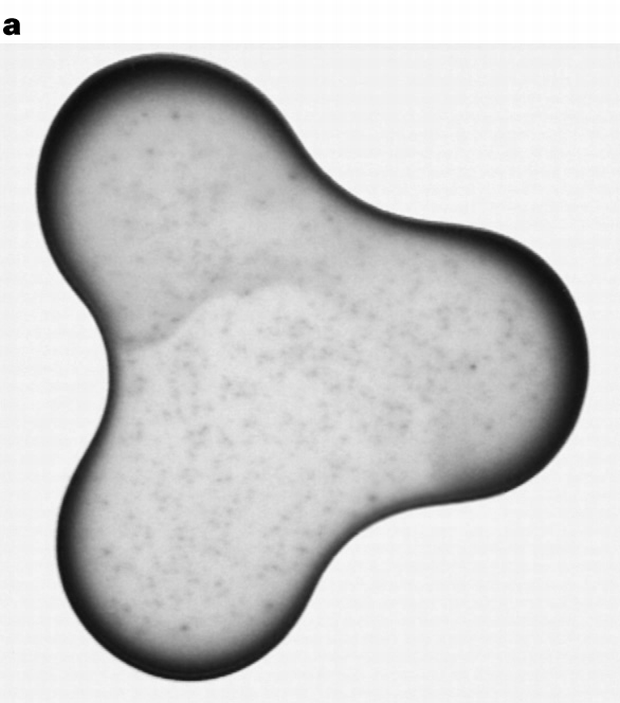- Letter
- Published: 23 October 1997
Nature volume 389, pages 827–829 (1997)Cite this article
-
60k Accesses
-
5707 Citations
-
110 Altmetric
Abstract
When a spilled drop of coffee dries on a solid surface, it leaves a dense, ring-like deposit along the perimeter (Fig. 1a). The coffee—initially dispersed over the entire drop—becomes concentrated into a tiny fraction of it. Such ring deposits are common wherever drops containing dispersed solids evaporate on a surface, and they influence processes such as printing, washing and coating1,2,3,4,5. Ring deposits also provide a potential means to write or deposit a fine pattern onto a surface. Here we ascribe the characteristic pattern of the deposition to a form of capillary flow in which pinning of the contact line of the drying drop ensures that liquid evaporating from the edge is replenished by liquid from the interior. The resulting outward flow can carry virtually all the dispersed material to the edge. This mechanism predicts a distinctive power-law growth of the ring mass with time—a law independent of the particular substrate, carrier fluid or deposited solids. We have verified this law by microscopic observations of colloidal fluids.

a, A 2-cm-diameter drop of coffee containing 1 wt% solids has dried to form a perimeter ring, accentuated in regions of high curvature. b, Spheres in water during evaporation, as described in the text. Multiple exposures are superimposed to indicate the motion of the microspheres.
This is a preview of subscription content, access via your institution
Access options
Subscribe to this journal
Receive 51 print issues and online access
$199.00 per year
only $3.90 per issue
Buy this article
- Purchase on SpringerLink
- Instant access to full article PDF
Prices may be subject to local taxes which are calculated during checkout
Additional access options:
Similar content being viewed by others
Change history
07 April 2021
A Correction to this paper has been published: https://doi.org/10.1038/s41586-021-03444-z
References
Parisse, F. & Allain, C. Shape changes of colloidal suspension droplets during drying. J. Phys. II 6, 1111–1119 (1996).
El Bediwi, A. B., Kulnis, W. J., Luo, Y., Woodland, D. & Unertl, W. N. Distributions of latex particles deposited for water suspensions. Mater. Res. Soc. Symp. Proc. 372, 277–282 (1995).
Denkov, N. D. et al. Mechanism of formation of two-dimensional crystals from latex particles on substrates. Langmuir 8, 3183–3190 (1992).
Laden, P. (ed.) Chemistry and Technology of Water Based Inks(Blackie Academic & Professional, London, (1997)).
TAPPI New Printing Technologies Symposium 1996(TAPPI Press, Atlanta, (1996)).
Hisatake, K., Tanaka, S. & Aizawa, Y. Evaporation of water in a vessel. J. Appl. Phys. 73, 7395–7401 (1993).
Peiss, C. N. Evaporation of small water drops maintained at constant volume. J. Appl. Phys. 65, 5235–5237 (1989).
Maxwell, J. C. Scientific Papers Vol. 2(Cambridge, (1890)).
Jackson, J. D. Classical Electrodynamics2nd edn, 77 (Wiley, New York, (1975)).
Lide, D. R. (ed.) CRC Handbook of Physics and Chemistry77th edn, 6–8, 6–218 (Chemical Rubber Publishing Co., Boca Raton, FL, (1996)).
Crocker, J. C. & Grier, D. G. Methods of digital video microscopy for colloidal studies. J. Colloid Interface Sci. 179, 298–310 (1996).
Acknowledgements
We thank H. Li, X. Shi and M. Baildon for their early contributions to this project; J. Crocker, D. Grier and A. Marcus for sharing their expertise, their image analysis code and their facilities; and S. Garoff, L. Mahadevan, S. Esipov, R. Leheny, D. Mueth, E. Ehrichs, J. Knight, S. Blanton, N. Menon, J. Cina and L. Kadanoff for discussions. This work was supported by the NSF-MRSEC, NSF and DOE.
About this article
Cite this article
Deegan, R., Bakajin, O., Dupont, T. et al. Capillary flow as the cause of ring stains from dried liquid drops. Nature 389, 827–829 (1997). https://doi.org/10.1038/39827
Received: 01 May 1997
Accepted: 26 August 1997
Issue Date: 23 October 1997
DOI: https://doi.org/10.1038/39827
.png)



